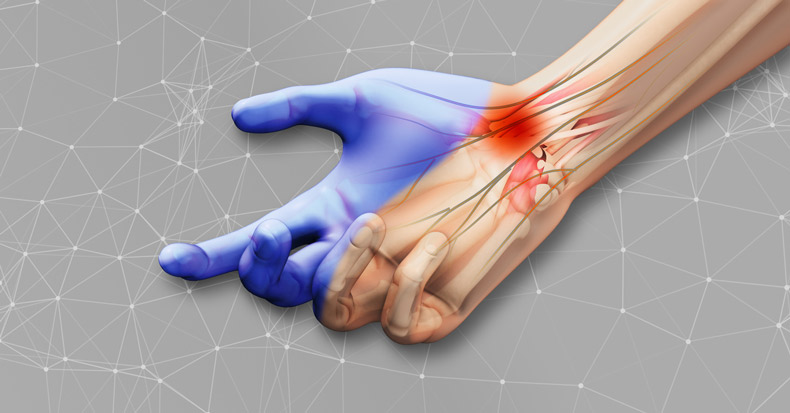The carpal tunnel is a narrow passageway on the palm side of the wrist, enclosed by bones and ligaments, that the median nerve and several flexor tendons pass through. When the mobility of the median nerve is restricted at this point, the resulting symptoms of numbness, tingling, pain, and weakness in the thumb, index, middle, and thumb side of the ring finger are collectively classified as carpal tunnel syndrome.
There are several potential causes of median nerve restriction or compression, which may co-occur and need to be addressed to provide the patient with a satisfactory outcome. The most commonly considered cause of CTS is repetitive movements of the hand and fingers that cause inflammation in the wrist as the tendons that pass through the carpal tunnel continuously rub against one another. This can be exacerbated by non-neutral wrist postures and excessive vibration, which increase pressure in the wrist. Additionally, compression of the median nerve elsewhere along its course from the neck to the hand can make the nerve more susceptive to restriction in the wrist.
Chronic health conditions can also contribute to carpal tunnel syndrome. For example, thyroid disorders can lead to fluid retention in the wrist, causing swelling and nerve compression. Likewise, women on birth control and who are pregnant can also experiencing hormonal changes that can lead to swelling and median nerve restriction. Rheumatoid arthritis can cause inflammation in the wrist and diabetes has been linked to nerve damage, both of which can hinder the function of the median nerve and result in the symptoms associated with CTS.
Diagnosis typically involves a review of the patient’s medical history and a physical examination, though more advanced diagnostics like nerve conduction studies, electromyography, ultrasound, and magnetic resonance imaging (MRI) may be ordered in some cases to better assess the condition. Hopefully, the patient did not delay treatment for too long and they’re a candidate for conservative treatment, such as a multimodal approach from a chiropractor.
Chiropractic treatment may include manual therapies, specific exercises, nocturnal wrist splinting, activity modification, physiotherapy modalities, and dietary/supplement recommendations all with the goal of reducing inflammation and restoring normal motion to the affected tissues. If chronic health problems may be suspected to have a role in the patient’s presentation, their chiropractor may co-manage the case with an allied healthcare provider such as the patient’s medical physician or a specialist. Should conservative chiropractic treatment fail to benefit the patient, they their chiropractor may refer them out for more invasive treatment such as corticosteroid injections or consultation with a surgeon for open or endoscopic release, which cuts the transverse carpal ligament that makes up the floor of the carpal tunnel to relive pressure. The good news is that most patients can find relief with conservative care and will not require surgical intervention.
